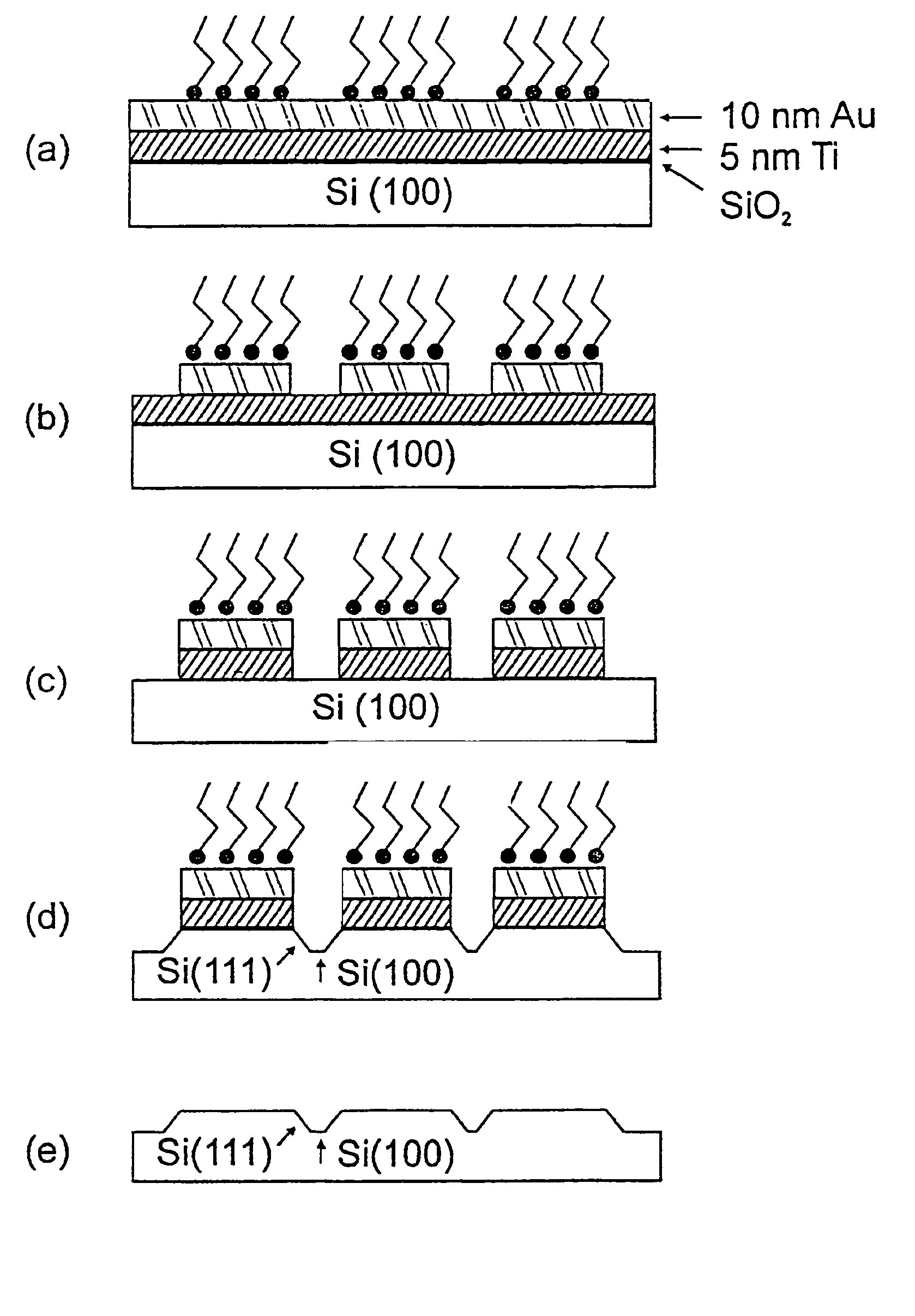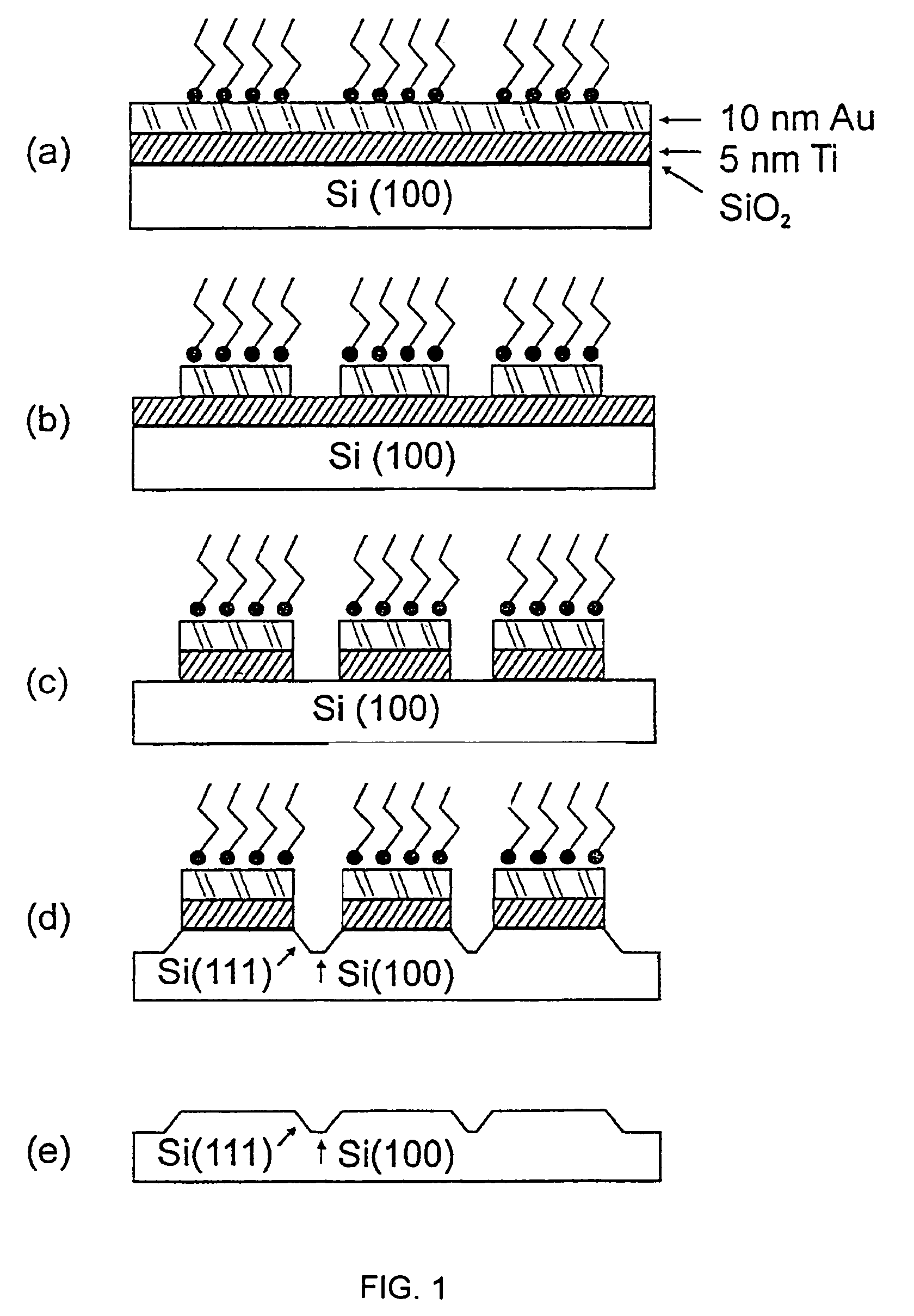Fabrication of sub-50 nm solid-state nanostructures based on nanolithography
a solid-state nanostructure and nanolithography technology, applied in nanoinformatics, photomechanical equipment, instruments, etc., can solve the problems of expensive equipment used in electron beam lithography, and achieve the effect of high resolution
- Summary
- Abstract
- Description
- Claims
- Application Information
AI Technical Summary
Benefits of technology
Problems solved by technology
Method used
Image
Examples
working example 1
[0072]Introductory description for the working example is provided, supplementing the above introductory description. Lithographic techniques such as photolithography (Wallraff and Hinsberg, Chem. Rev., 99:1801 (1999)), electron beam lithography (Wallraff and Hinsberg, Chem. Rev., 99:1801 (1999); Xia et al., Chem. Rev., 99:1823 (1999)), and microcontact printing (Xia et al., Chem. Rev., 99:1823 (1999)) can be used with varying degrees of ease, resolution, and cost to generate three-dimensional features on silicon wafers. DPN is complementary to other aforementioned nanolithographic techniques, but can be used with conventional laboratory instrumentation (an AFM), in routine fashion, to generate patterns of alkylthiols on polycrystalline gold substrates under ambient conditions. Moreover, DPN offers 15 nm linewidth and 5 nm spatial resolution with conventional AFM cantilevers. (see prior examples, Piner et al., Science, 283:661 (1999); Piner et al., Langmuir, 15:5457 (1999); Hong et ...
working example 2
[0092]In a typical experiment, gold-coated (10 nm), Ti-coated (1 nm) silicon oxide (Au / Ti / SiOx / Si) (references 6a,b) was patterned via DPN™ printing with 16-mercaptohexadecanoic acid (MHA) using a Park Scientific CP AFM (Thermomicroscopes, Sunnyvale, Calif.) and commercial lithography software (DPNWrite™, DPN System-1, NanoInk Inc., Chicago, Ill.) (references 5, 6a,b). All patterning experiments were carried out under ambient conditions (set point=0.5 Nn, 24-26° C., 44-49% relative humidity) with a MHA-coated tip, which was prepared by immersing a Si3N4 tip (spring constant=0.05 N / m, Thermomicroscopes, Sunnyvale, Calif.) in an acetonitrile solution saturated with MHA for ˜5 s with subsequent drying with compressed difluoroethane (Dust-off, Ted Pella, Inc., Redding, Calif.). Each DPN dot feature was generated by holding a MHA-coated tip in contact with an Au surface for 0.01 s (i.e., a holding time), and each line was generated by moving a MHA-coated tip on an Au surface at a constan...
working example 3
[0095]In a typical experiment, 20 μm long lines of MHA were generated by moving a MHA-coated tip on an Au surface at a rate 0.5 (FIG. 7A), 0.25 (FIG. 7B), and 0.25 (FIG. 7C) μm / s with a designed gap distance of 100 (FIG. 7A), 90 (FIG. 7B), and 20 nm (FIG. 7C), respectively. After etching the exposed areas of the Au film with a ferri / ferrocyanide etchant (reference 6a), TMAFM images show that the measured sizes of the obtained nanogaps are ˜97 (FIG. 7A), 82 (FIG. 7B), and 12 (FIG. 7C) nm (see FIGS. 10-12 for section analysis), respectively. The obtained gap sizes are a little smaller than the designed gap sizes, possibly a consequence of MHA diffusion, which in some cases may not be fully accounted for in the software or experimental protocol, and which in some cases may not take into account differences in the ink diffusion as a function of tip coating. The widths of the etched lines are about 70 (FIG. 7A), 170 (FIG. 7B) and 165 (FIG. 7C) nm, respectively. These data show that one c...
PUM
| Property | Measurement | Unit |
|---|---|---|
| distances | aaaaa | aaaaa |
| distances | aaaaa | aaaaa |
| deposition time | aaaaa | aaaaa |
Abstract
Description
Claims
Application Information
 Login to View More
Login to View More - R&D
- Intellectual Property
- Life Sciences
- Materials
- Tech Scout
- Unparalleled Data Quality
- Higher Quality Content
- 60% Fewer Hallucinations
Browse by: Latest US Patents, China's latest patents, Technical Efficacy Thesaurus, Application Domain, Technology Topic, Popular Technical Reports.
© 2025 PatSnap. All rights reserved.Legal|Privacy policy|Modern Slavery Act Transparency Statement|Sitemap|About US| Contact US: help@patsnap.com



